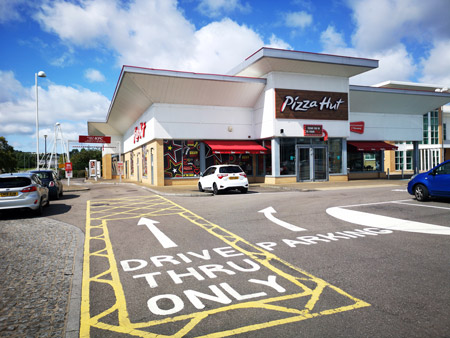Leading REIT analysts review the outlook for the data center, health care, industrial, infrastructure, lodging, multifamily, office, retail, self-storage, and timber real estate sectors.

The impact of the COVID-19 crisis has been felt in every corner of the commercial real estate industry. Shuttered businesses, job losses, widespread economic uncertainty, and changes in consumer habits have all upended previous forecasts for 2020.
While the outlook varies according to property type, many REIT sectors look poised to experience pressure on vacancy rates, property prices, and rent growth in the months ahead. Looking further ahead, however, the prudent steps REITs have taken since the global financial crisis to shore up balance sheets and fortify portfolios are expected to help them withstand the longer-term challenges resulting from the pandemic.
Data Center REITs Backed by Long Term Demand Drivers
The demand profile for data center REITs has been solid for many years, driven by powerful long term drivers like cloud adoption and outsourcing, says Nick Del Deo, senior analyst at MoffettNathanson LLC. “What the pandemic has done is really highlight the importance of having robust, flexible digital architectures—and it’s made that clear among the most senior leaders in every organization,” he adds, which could serve to reinforce demand in coming years.
Data center REITs have been one of the better positioned REIT sectors during the coronavirus crisis, Del Deo notes. While some data center customers have been facing real hardships, another subset of customers “are really pressing the gas.” The net effect, he says, is roughly a wash from a near term demand perspective. For the data center REITs’ biggest customers—cloud and hyperscale players like Microsoft, Google, Apple, Facebook, and Salesforce—demand remains robust, according to Del Deo.
 From an operational perspective, while data center REITs have had some hiccups in terms of permitting, construction, and customer access to facilities, they have been pretty modest overall, Del Deo says. “For 2020, there should be little to no net impact on their business.”
From an operational perspective, while data center REITs have had some hiccups in terms of permitting, construction, and customer access to facilities, they have been pretty modest overall, Del Deo says. “For 2020, there should be little to no net impact on their business.”
And while data center REITs still have a substantial runway for growth in the U.S., overseas markets can offer attractive opportunities to leverage existing customer relationships as those customers’ direct investment is toward regions that are less digitally mature, Del Deo says.
Looking ahead, some of the challenges Del Deo sees for the sector include its competitive nature and capital intensive growth profile, which has tended to compress development yields and weigh on per-share profit metrics for less differentiated operators.
Health Care REITs Face New Risks
There’s uncertainty about the impact of the virus on every property type owned by health care REITs, says Jordan Sadler, a managing director and equity research analyst with KeyBanc Capital Markets.
Senior housing is almost universally thought of as the most at-risk because it’s 100% private pay and 100% occupied by seniors, who are vulnerable to the coronavirus, Sadler says. They elect to live in these communities to socialize and take advantage of services. The average stay is about two years, with roughly a 4% turnover every month, he explains.
 In normal times, move-ins offset the move-outs, but right now senior housing communities are seeing occupancy decline, as new move-ins have fallen due to shutdowns and caution attributable to COVID-19, according to Sadler.
In normal times, move-ins offset the move-outs, but right now senior housing communities are seeing occupancy decline, as new move-ins have fallen due to shutdowns and caution attributable to COVID-19, according to Sadler.
“Senior housing was already over-supplied pre-COVID and it’s a lower margin business than other real estate, so this isn’t a great dynamic,” he says. “Expenses are also going up, due to rising labor costs, as staffers of COVID-infected facilities may be eligible for hazard pay.” Once a vaccine is developed, however, Sadler believes these communities will thrive.
COVID-19 has raised expenses for skilled nursing centers, another low margin business, but Sadler believes this will have only a short-term impact since these are need-based facilities that mostly serve Medicaid and Medicare patients. “It’s an election year, so it wouldn’t look good for anyone to initiate cutbacks on the other side of COVID-19,” Sadler says.
Medical offices are the least impacted by the virus in the long-term because demand from the aging baby boomer population cohort continues to grow and the need to temper the pace of rising health care is pushing procedures toward lower cost settings like doctors’ offices in lieu of hospitals, Sadler says.
“Telemedicine and your local CVS clinic can’t do everything, particularly the kinds of medicine practiced at specialty offices owned by REITs,” such as oncologists, cardiologists, orthopedists, imaging centers, and ambulatory surgery centers, Sadler adds.
Industrial Sector Thriving
The pandemic is having both short-term and long-term positive impacts on the industrial sector, says John Guinee, managing director at Stifel, starting with an accelerated transition to e-commerce that increases the need for more inventory nearby.
“The perception is that COVID-19 benefits e-commerce, requires more inventory of emergency supplies in warehouses, and benefits onshoring in the supply chain because the last thing we want is to rely on China or some other country for supplies when we need them,” he says.
“Regardless of the property type, everyone is concerned about the collection ratio, but in the industrial sector, there’s been a very good collection ratio with a manageable number of tenants requesting mitigation,” Guinee says. “That helps give investors confidence in the sector.”
 Within the industrial sector, though, there are differences in performance depending on the type of tenants and the location. For example, Guinee says, big box distribution sites are thriving because of e-commerce, but properties with smaller tenants whose businesses have temporarily or perhaps permanently closed are weaker.
Within the industrial sector, though, there are differences in performance depending on the type of tenants and the location. For example, Guinee says, big box distribution sites are thriving because of e-commerce, but properties with smaller tenants whose businesses have temporarily or perhaps permanently closed are weaker.
“REITs invested primarily in Houston are struggling a bit because of the oil industry and those with assets close to ports could be hurt by the downturn in global trade,” Guinee says. The consensus is that a clear winner in this crisis are the Sunbelt and Southern states because the great affordability migration that was already happening will be enhanced by COVID-19, he adds. There’s more concern about New York, but historically that has been a resilient city, he adds.
Nationally, vacancy rates for industrial properties are below 5% and rents are 15% to 20% below market, Guinee says.
“Even in dire circumstances, such as if 200 million square feet of new space gets delivered and only 100 million square feet gets absorbed, national vacancy rates would still be below 5.5%,” Guinee says. “There’s lots of cushion with low in-place rents, because even if rents generally go down by 20%, the tenants in place would still renew at current rates because they’re already below market.”
Positive Signals for Infrastructure REITs
While the coronavirus has definitely accelerated many of the trends that were already supporting the infrastructure sector, Jennifer Fritzsche, managing director at Wells Fargo Securities, says it isn’t surprising that small cell and tower construction has slowed a bit, given supply chain issues, social distancing, and the fact that municipalities have not been open to move forward with permits.
“On the other side of COVID, I think there’s going to be more urgency around 5G and edge computing,” she says. While there will still be issues with zoning, “I think things will move forward pretty aggressively,” she adds. At the same time, 4G network densification through the use of small cell technology is also taking on greater impetus.
From a balance sheet perspective, infrastructure REITs are all very well-positioned, according to Fritzsche. “They do have high leverage, but unlike many other REIT sectors they have more tailwinds than headwinds. They have very long term contracts with built-in escalations. One thing this crisis has shown is that connectivity is key. Going forward, urgency around connectivity will be absolutely critical,” she says.
Meanwhile, Fritzsche sees a continued morphing of the traditional broadband infrastructure silos. Whereas fiber, towers, data centers, and small cells used to each be their own segment, those lines appear to be blurring as REITs look to broaden their reach, she notes.
A key impetus for the infrastructure sector in the months and years ahead will be the impact of the T-Mobile/Sprint merger. Fritzsche says that while “you always want more customers, not less, the positive side is that those customers have a lot to do.” There are going to be important spectrum auctions coming up with more spectrum deployed, she says, “and that’s a positive.”
Lodging Takes a Hit
Stay-at-home orders around the globe had a devastating impact on the hospitality sector, with both leisure and business travel coming to a halt and the industry facing a long road ahead toward recovery.
 “Intuitively it’s clear that the lodging sector is among the hardest hit,” says Lukas Hartwich, a senior analyst with Green Street Advisors. “RevPAR was down 80% between mid-March and the end of April, and while trends are improving, we expect the pain to continue for several more months.”
“Intuitively it’s clear that the lodging sector is among the hardest hit,” says Lukas Hartwich, a senior analyst with Green Street Advisors. “RevPAR was down 80% between mid-March and the end of April, and while trends are improving, we expect the pain to continue for several more months.”
In the short-term, many REITs temporarily closed hotels and shrunk the remaining hotels by closing off floors and reducing staff to cut costs.
“REITs benefit from having access to multiple sources of capital and generally have access to large lines of credit, so right now they’re funding the shortfall with liquidity on hand,” Hartwich says. “Effectively they’re burning cash until things can return to some semblance of normal.”
Group activity is likely to be the weakest and last to recover, he says, because of social distancing and a reluctance of businesses to spend on conferences. “Leisure, especially ‘drive-to leisure’ locations will do better.”
In parts of the country that began lifting lockdown rules earlier, hotels will also make a faster comeback, according to Hartwich.
“Before the virus, we were projecting modest net operating income (NOI) declines for hotels because we were late in the economic cycle, there was an oversupply in many markets, and hotels were facing higher labor costs,” Hartwich says. “But REITs are generally in better shape than private owners given lower financial leverage and greater access to capital markets.”
Hartwich adds that some REITs will have to raise capital, extend their debts, and sell some assets to get through this rough patch.
“We’re still in the eye of the storm right now, but at least the pace of declines is starting to ease,” he says.
Multifamily Expenses Rising
The level of apartment rent collections in May remained at 95%, essentially flat with April collections, according to a survey conducted by Nareit.
James Sullivan, managing director and REIT analyst at BTIG, says the second quarter of the year is important for multifamily investors because that’s when young people graduate, rent apartments, and occupancy rates are strongest.
“We expect a decline in occupancy this year because of job losses and the possibility of a decline in demand in high-density cities with high infection rates. Some people who can work remotely have gone home to live with their parents and they may decide to stay.”
Despite an expected higher-than-normal renewal rate because of the disinclination to move during the emergency, Sullivan says the drop in new leases will likely result in a 3% to 6% decline in occupancy rates in 2020.
“Rents for renewals have been rising 4% to 6% annually, but with a slower economy we’re not likely to see any growth on renewal rates,” Sullivan notes. “Rents on new leases will be down 4% to 5% because of the slow economy and supply growth in many markets. Altogether we expect to see an 11% decline in revenue.”
Another headwind for multifamily owners is high operating expenses, about 40% of which are taxes and insurance.
Taxes have already been trending higher and there may be upward pressure in major cities because of the loss of revenue from sales taxes and hotel occupancy taxes while the economy has been shut down, according to Sullivan.
Markets with high exposure to the hospitality and retail industries, such as Orlando and Las Vegas, will see a more significant economic impact than places like Washington, D.C., which tends to hold up better during a recession, Sullivan says. Portfolios with a suburban presence and apartments in markets with lower rates of infection, fewer job losses, and a lower cost of living will feel safer to investors.
“We’ll see a significant slowdown in capital spending until revenues begin to increase again,” Sullivan says. Financing is going to be more difficult to get and so a slowdown in completions of new projects is likely. Liability coverage costs may go up and so will operations costs as owners add security and health protocols to protect tenants, he notes
Office REITs Take the Long View
The impact on office REITs from COVID-19 depends on when and how businesses return to normal.
“In the short-term, office owners had to figure out how to keep functioning, keep employees safe, and keep the utilities running,” says David Rodgers, a senior research analyst for Baird. “Everyone is keeping an eye on collections. Collections in May improved from those in April, and conversations related to June appear healthy.”
Most office leases range from five to 15 years, which limits the short-term impact of the crisis, Rodgers says.
“The big question is who can survive after this, which depends a little on which companies were strong and which were marginal going into the crisis,” Rodgers says. Operating costs may be a little lower for buildings that are mostly empty and therefore have lower utility costs. The bigger losses in the short-term are from ground floor retail sites and from parking fees for offices in the central business districts, he says.
Some experts speculate that companies will shrink their space and keep more workers at home, while others suggest demand will grow because of the need for more space between workers.
 “My guess is that offices will be used, but they will be used differently,” Rodgers says. “There’s been fatigue already expressed about crunching so many people into smaller spaces, so that could move the needle in the direction of needing more space.”
“My guess is that offices will be used, but they will be used differently,” Rodgers says. “There’s been fatigue already expressed about crunching so many people into smaller spaces, so that could move the needle in the direction of needing more space.”
Every office REIT has a task force discussing new cleaning protocols, upgrading HVAC systems, and how to reopen buildings safely, Rodgers says. Since office REITs typically own high-quality buildings, Rodgers anticipates that those buildings will be favorable to tenants who will be looking for buildings with hospital grade systems for better air flow, more flexible floor plans, and bigger elevator cars.
Rodgers also expects to see big changes in co-working spaces because people won’t want to share workspace. That will result in a shift to suites and larger offices with fewer members. Most REITs have zero co-working tenants up to about 4% at most, he says, but those co-working operators have been among the largest absorbers of office space in New York and Washington, D.C., so that will have a negative impact on those markets.
Unlike the last economic cycle, Rodgers says, financing and liquidity are not an issue. Government and Federal Reserve intervention have provided the bridge to a reopening of the broader economy. Baird measures that through April, only 1 million of the approximately 5 million office jobs lost were considered to be permanent. Office job losses slowed to less than 200,000 positions in May—most of which were government related.
“There’s a potential risk depending on how long this lasts, but not a high one yet,” he says. “People still want to invest in REITs with the best balance sheet, the best assets, and the best corporate tenants.”
Retail Sector Faces Additional Headwinds
High-profile bankruptcies such as J. Crew and Neiman Marcus immediately demonstrated the toll the economic shutdown has had on the retail sector, which was already struggling in recent years.
 “Retail was hit hard and they’ve never experienced anything like the significant reductions in rent collections,” says Alexander Goldfarb managing director and senior research analyst at Piper Sandler.
“Retail was hit hard and they’ve never experienced anything like the significant reductions in rent collections,” says Alexander Goldfarb managing director and senior research analyst at Piper Sandler.
But Goldfarb says that doesn’t mean investors should write off the whole property sector.
“Everyone knows the warts about retail,” but not everyone fully appreciates the knock-on risks in other areas, he says. “Retail centers, particularly shopping malls, contribute to the local economy through employment and taxes, so failing retail is a community issue.”
Goldfarb anticipates that about 70% of mall tenants will survive this recession, with another 20% requiring a rent restructure and 10% going under.
“Some retail REITs have already suspended dividends because if you don’t get paid on the top, you can’t pay out the bottom,” he says. “Some have already improved their balance sheets and portfolios by selling properties and limiting their leverage. But they will survive.”
In the long run, consumers are likely to want to go shopping again, says Goldfarb.
“People appreciate the efforts that these retail sites have made to keep supplies coming, to employ people, to put limits in place to reduce hoarding and then to transition when they reopen to requiring masks and screening to keep people safe,” Goldfarb says. “People are likely to trust that the shopping mall has upgraded its HVAC and is holding its restaurants to higher standards.”
In the end, Goldfarb says, that leaves the advantage to the best landlords of the best properties, which are typically REITs.
Self-storage Supply Fundamentals Improving
Initial demand from new self-storage customers, as well as move-outs, fell during the early stages of the crisis, largely due to restricted mobility, says Smedes Rose, director at Citi. With movement now increasing, activity is picking up and “in general, it’s skewed a little bit better than we had originally anticipated,” he adds.
At the same time, operators no longer appear constrained to pass on price increases to in-place customers, Rose says. Pricing is likely to pick up through the back half of 2020 for in-place customers, which represent the vast majority of self-storage customers.
Based on discussions with management, Rose says the price increases that REITs are looking to put through do not deviate from those they would have implemented prior to the pandemic—typically in the high single digits or low double digits.
“The view was that the level of price increase really didn’t impact a customer’s decision about whether to move or not because it’s such a need-based business. As pricing is reinstituted, I wouldn’t look for any meaningful changes in the rate at which customers receive their rent hikes,” Rose says.
At the same time, Rose notes that operating margins could improve a little as REITs move to more contactless rentals, a trend that resonates well with a younger audience.
As for development, Rose says new storage deliveries are expected at about a 3.7% share of total stock in 2020 and about 8.7% through 2022. That pace has come down a fair amount from the past five years, he adds.
“There’s been a very aggressive pace of new deliveries, particularly in the core U.S. markets where most of the REITs are exposed. We’ve started to see that come down somewhat, which would be a positive from a supply demand perspective and would help overall fundamentals, but it will take a while to fully unfold,” Rose says.
Nationwide, the forecast for 2020 deliveries has shifted down about 10% and more than 25% in 2021 compared with original estimates, he notes.
Timber REITs Buoyed by Homebuilding
The general backdrop for the timber REIT segment is one of cautious optimism, given that homebuilding has remained fairly strong and there hasn’t been a huge slowdown in demand, says Charles Gross, equity analyst at Morningstar.
However, “2020 will be a tough year, there’s no doubt about it, but these companies are used to the ebbs and flows of the economy,” Gross says. Within the REIT universe, timber REITs are among the least harmed by the coronavirus crisis, he adds.
As the crisis has progressed, it’s been clear that housing has not suffered anywhere near the same slowdown that’s been seen throughout the rest of the economy, Gross says. In general, purchase applications are still quite high, and homes are selling after about a decade of “pretty lean” home construction, he adds.
Longer term, however, Gross points to a more challenging outlook for timber REITs from a valuation perspective. A key reason for that reflects the fact that forests in the South are “so remarkably well-stocked.”
“Most of the South is looking down the barrel at almost 50% fuller forests than in 2005. It’s a huge magnitude of timber growth, reflecting a lack of demand and a surge of supply from some of the smaller players,” Gross says. “Even a bullish housing forecast for the next 10 years would not see the amount of excess growth whittled down to the point where we see that pricing come back to where it was.”